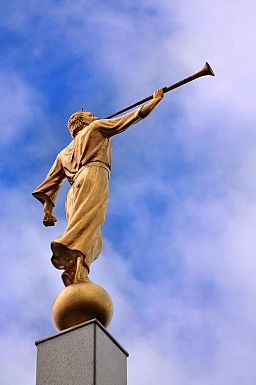For National Suicide Prevention week, Main Street Plaza reviews a study of active and former Church members

Tyler Lefevor, Utah State University
A team of researchers investigated whether active Latter-day Saints were different from inactive and former members in terms of how and how much they thought about suicide. Over 600 people identifying as sexual minorities (including gay, bisexual, pan-sexual, and same-sex attracted) answered dozens of questions about their sexual identity, well-being, and religious feelings.
The upshot? There are differences, but in both groups, concealing one’s identity can be deadly, and support from friends can save lives.
Here is an interview with Tyler Lefevor, assistant professor at Utah State University, who led this work, which was published earlier this year in the Journal of Community Psychology.
MB: What is the top take-home message from this research?
TL: Generally, I think it’s important to recognize that both active and nonactive members had struggles and ways of being resilient. This study really highlights that the struggles and resilience were simply different for the two groups. As people who care about LGBTQ Mormons, perhaps the best thing we could do is to lend a listening ear to the unique struggles of the people we love.
MB: In both groups, you found ‘concealment’ is strongly associated with more suicidal ideation while ‘support’ from friends and family is associated with less.
TL: One of the most harmful things that LDS sexual minorities can do is to not share their experience with others. Sharing about their sexual orientation allows others to offer support and care, which helps reduce suicidal ideation. Although it can feel frightening, sharing about sexuality can allow LDS sexual minorities to deepen relationships with those who will be supportive and to pull back from relationships from people who will not be supportive.
MB: You classify the factors associated with less suicide ideation as ‘resources.’ Which are the most powerful?
TL: Generally, resolving conflict between sexual or gender and religious identities and having support from family or friends were the most powerful resources. These things helped people feel less suicidal regardless of whether they were engaged or disengaged with the church.
MB: What factors were associated with more suicide ideation?
TL: A handful of variables were consistently linked with more suicidal ideation. Having internalized negative views about being a sexual or gender minority and hiding one’s sexual attractions or gender identity from others were among the strongest predictors of suicidal ideation.
We also found that leaning on God as a way of coping with life’s hardship was related to more suicidal ideation, though this may have been because people lean on God more when they’re already experiencing more suicidal ideation.
Finally, negative interactions with other religious people were a pretty big risk.
MB: Were there differences for people who were active Church members versus nonactive?
TL: A few important differences between groups emerged. People who were active Church members were more religious and had more support from family. People who were not active tended to have more support around their sexual identity.
MB: Is it fair to say that nonactives cope by taking pride in their sexuality and actives by taking pride in their faith?
TL: I think that’s pretty close. It seems that we’re seeing two groups of people who find their community in two different places. Interestingly enough, it seems like they are reporting pretty similar degrees of mental health, which may suggest that turning to these communities is a helpful coping strategy.
MB: So nonactives who said they, say, frequently asked God for forgiveness or love had more suicidal ideation, while actives were at higher risk if they felt hurt and misunderstood?
TL: Yeah, it’s complicated. So, fewer nonactive individuals tended to turn to God for forgiveness, but it seems like when they did, it went less well for them. Similarly, perhaps because active individuals are more engaged in church activities, when they have negative experiences there, it seems to be more impactful for them.
MB: Those of you carrying out the survey include former Church members in same-sex partnerships as well as active members in mixed-orientation partnerships. Can you talk about how that spectrum helps and hinders the research?
TL: It was really important for us as a research team to try and represent the people we were studying. By having diversity within our team, we were able to check our biases and assumptions. Committing to either a same-sex or mixed-orientation relationship can tend to make someone expect that their way of life is the best way for all LGBTQ people, so this kind of intentional research team creation was a way for us to be sure that we were not telling people the best way to live their lives but rather asking them.
We were really interested in collecting a diverse set of experiences from LGBTQ Mormons so that we could help LGBTQ Mormons who are trying to make decisions about their faith, gender, and/or sexuality. Our hope was that we could survey enough people that represented enough different views that the results would be fairly representative of LGBTQ Mormons as a general group.
MB: How did you measure deeply personal traits like religiosity/spirituality, internalized homonegativity, and so on?
TL: It is tough! Our survey is far from perfect. It took participants about 45 minutes to complete. We will be launching a revised version later this year or early next year. If you’re interested in being part of it, you can give us your name and email at www.4optionssurvey.com.

Interesting and timely interview! His point that concealment is especially toxic resonates. And his study shines a light on what used to be a hidden community within Mormonism.
We also found that leaning on God as a way of coping with life’s hardship was related to more suicidal ideation, though this may have been because people lean on God more when they’re already experiencing more suicidal ideation.
A correlation between suicide and certain flavors of Christian belief is longstanding. Early Calvinists, for instance, committed suicide so often that Catholics used that as proof that Protestantism was of the devil. But Calvinism’s god was such a cruel, vindictive bastard who hated all but the tiniest sliver of humanity so thoroughly that it’s hardly surprising people didn’t find leaning on him for comfort very effective. And Mormonism has plenty of roots in Calvinism.